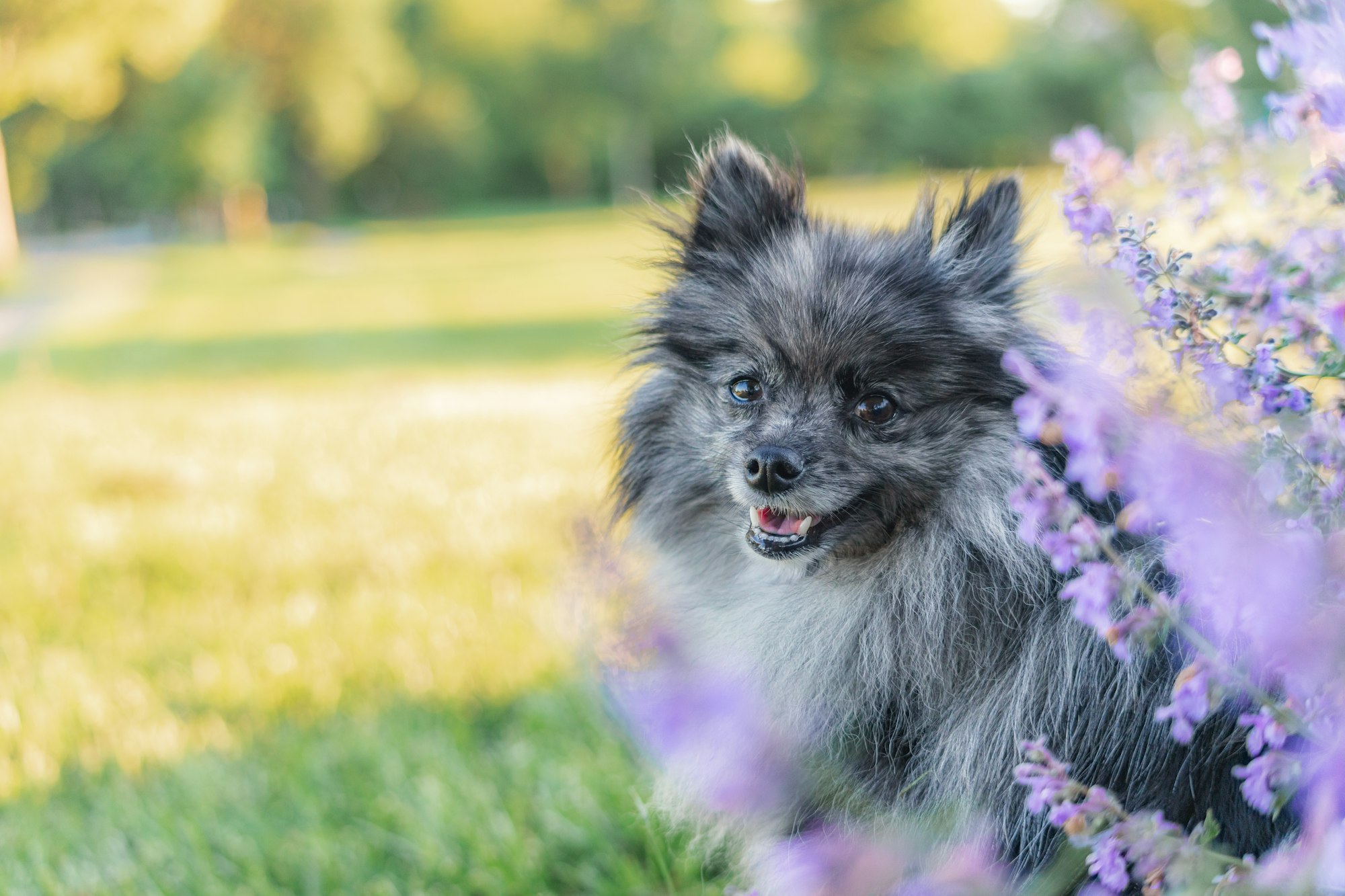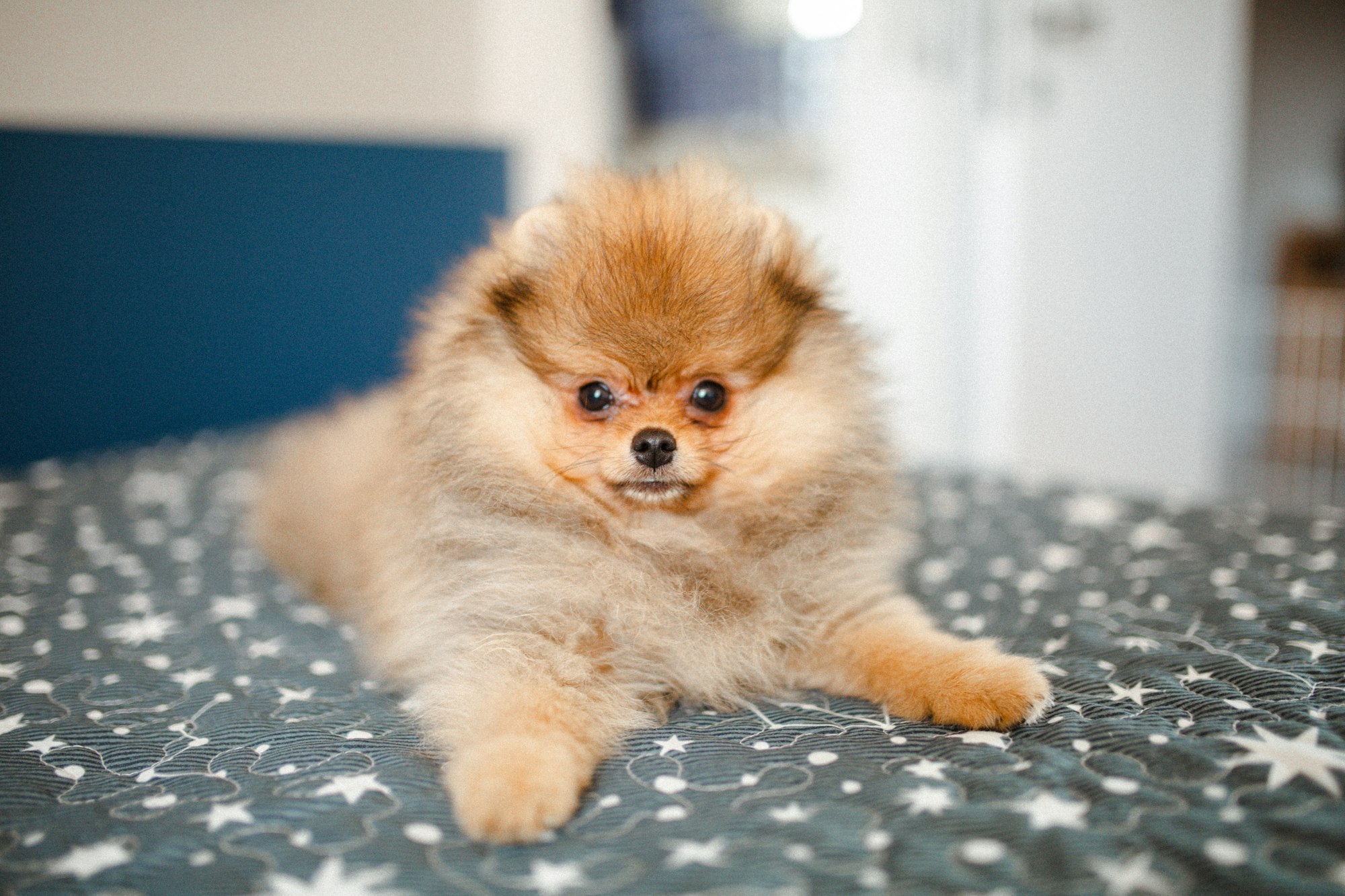From their captivating coat patterns to their friendly and playful demeanor, Merle Pomeranians have become increasingly popular among dog enthusiasts worldwide. This article delves into the fascinating world of Merle Pomeranians, exploring their origins, distinct characteristics, care requirements, and more. Whether you're considering adding one to your family or simply curious about this delightful breed, read on to discover the unique charm of the Merle Pomeranian.

Origins of the Merle Pomeranian
The Merle Pomeranian is a variation of the Pomeranian breed, which originated in the Pomerania region of Central Europe. These small dogs were initially bred for herding and guarding purposes but eventually gained popularity as companion animals. The Merle gene, responsible for the unique coat pattern seen in these Pomeranians, is thought to have originated from crossbreeding with other breeds.
Understanding the Merle Coat Pattern
The Merle coat pattern is characterized by a mottled or marbled appearance, with patches of diluted colors on a base coat. The irregular distribution of pigments creates a mesmerizing visual effect that sets Merle Pomeranians apart from other variations. It's important to note that while the Merle pattern is visually striking, responsible breeding practices prioritize the health and well-being of the dogs to avoid certain genetic health issues associated with excessive Merle breeding.
Distinctive Features of Merle Pomeranians
Merle Pomeranians is a unique variation of the popular Pomeranian breed. They are known for their distinctive coat pattern, which displays a marbled or mottled effect with patches of different colors. Here are some key features that set Merle Pomeranians apart:
a. Coat Color: The most prominent characteristic of Merle Pomeranians is their Merle coat coloration. The base dog coat color can be any solid shade, such as orange, black, sable, or cream, with patches or streaks of a lighter or darker color, typically gray or black. The merle pattern can vary in intensity, ranging from a few patches to a heavily mottled appearance.
b. Eye Color: Merle Pomeranians often have captivating and striking eye colors. The Merle gene can cause variations in eye pigmentation, resulting in blue, green, amber, or partially colored eyes. Some Merle Pomeranians may even have heterochromia, where each eye is a different color.
c. Size: Merle Pomeranians fall within the standard size range for Pomeranians. They are typically small dogs, weighing between 3 to 7 pounds (1.4 to 3.2 kilograms) and standing around 6 to 7 inches (15 to 18 centimeters) tall at the shoulder.
d. Overall Appearance: Apart from their unique coat pattern, Merle Pomeranians exhibit the same physical characteristics as other Pomeranians. They have compact and sturdy body, a fox-like face with a pointed muzzle, erect ears, and a plumed tail that arches over their back.
Temperament and Personality:

Merle Pomeranians, like other Pomeranians, are known for their lively and outgoing personalities. Here are some common temperament traits associated with Merle Pomeranians:
a. Playful and Energetic: Merle Pomeranians are highly energetic dogs that enjoy playtime and interactive activities. They have a cheerful demeanor and love to engage in games and exercises that stimulate both their body and mind.
b. Alert and Vocal: Pomeranians, including Merles, have a keen sense of awareness and tend to be quite vocal. They make excellent watchdogs and will alert their owners to any perceived threats or changes in their environment.
c. Intelligent and Trainable: Merle Pomeranians are intelligent dogs that can quickly grasp commands and learn new tricks. They respond well to positive reinforcement-based training methods and enjoy mental stimulation.
d. Affectionate and Loyal: Merle Pomeranians form strong bonds with their owners and thrive on human companionship. They are affectionate and enjoy being the center of attention, often displaying loyalty and devotion to their family members.
Training and Socialization:
Training and socialization are essential aspects of raising a well-behaved Merle Pomeranian. Here are some key points to consider:
a. Early Training: Start training your Merle Pomeranian puppy as early as possible. Begin with basic commands like sit, stay, and come, and gradually progress to more advanced training sessions. Consistency, patience, and positive reinforcement are key to successful training.
b. Socialization: Introduce your Merle Pomeranian to various people, animals, and environments from a young age. This helps them develop good social skills, become more comfortable in different situations, and reduce the likelihood of behavioral issues.
c. Exercise and Mental Stimulation: Provide regular exercise and mental stimulation to keep your Merle Pomeranian physically and mentally fit. Daily walks, interactive play sessions, and puzzle toys can help prevent boredom and promote a well-balanced temperament.
d. Positive Reinforcement: Merle Pomeranians respond best to positive reinforcement techniques, such as praise, treats, and rewards. Avoid harsh or punitive training methods, as they can lead to fear or aggression.
e. Consistency and Routine: Establish a consistent routine for your Merle Pomeranian, including feeding times, potty breaks, and training sessions. Consistency helps them understand expectations and promotes good behavior.
Remember, every dog, including Merle Pomeranians, is an individual, and their temperament and training needs can vary. It's significant to provide love, care, and individualized attention to ensure a happy and well-adjusted companion.
Grooming and Care Tips
Proper grooming and care are crucial for keeping your Merle Pomeranian healthy and maintaining their beautiful coat. Here are some grooming tips:
a. Brushing: Merle Pomeranians have a thick double coat that requires regular brushing to prevent matting and tangles. Brush their coat at least two to three times a week using a slicker brush or a comb with wide-set teeth. Pay extra attention to areas like the neck, chest, and behind the ears.
b. Bathing: Bathe your Merle Pomeranian every 4-6 weeks or as needed. Use the best dog shampoos for sensitive & itchy skin and ensure thorough rinsing to avoid skin irritations. Be cautious not to over-bathe, as it can strip their coat of natural oils.
c. Coat Maintenance: Merle Pomeranians may shed moderately throughout the year and heavily during shedding seasons. Regular brushing helps minimize loose hair and keeps the coat healthy. Trim their nails regularly, check their ears for debris or infection, and brush their teeth to maintain good oral hygiene.
d. Professional Grooming: Consider taking your Merle Pomeranian to a professional groomer for occasional grooming sessions. They can trim the coat, tidy up the dog paws pads, and ensure your dog's overall grooming needs are met.
Health Considerations:
Merle Pomeranians, like any other dog breed, may be prone to certain health conditions. While not all Merles will develop these issues, it's necessary to be aware of potential health considerations, which may include:
a. Merle-Related Health Concerns: Merle coat pattern is associated with a higher risk of certain health issues in some breeds, such as deafness, vision problems, and skin abnormalities. It is recommended to obtain a Merle Pomeranian from a reputable breeder who conducts appropriate health screenings.
b. Patellar Luxation: This condition involves the displacement of the kneecap and can affect Pomeranians. Regular veterinary check-ups can help detect and manage this issue if present.
c. Dental Problems: Pomeranians, including Merles, are prone to dental issues like tooth decay and gum disease. Daily teeth brushing and routine dental check-ups are essential for maintaining good oral health.
d. Obesity: Pomeranians can be prone to obesity if not provided with a balanced diet and sufficient exercise. Monitor their food intake, provide them with a healthy diet, and engage in regular exercise to prevent weight gain.
Regular veterinary visits, a balanced diet, proper exercise, and attention to their overall well-being can help keep your Merle Pomeranian in good health.
Exercise and Activity Requirements:
Merle Pomeranians may be small in size, but they still require regular exercise and mental stimulation. Here are some exercise and activity tips:
a. Daily Walks: Take your Merle Pomeranian for daily walks to provide them with physical exercise and mental stimulation. Aim for at least 20-30 minutes of brisk walking per day. Adjust the intensity and duration of the walk based on your dog's age, health, and energy level.
b. Indoor Play: Engage your Merle Pomeranian in interactive play sessions indoors, especially during inclement weather. Use toys, play fetch, or create obstacle courses to keep them active and entertained.

c. Mental Stimulation: Merle Pomeranians are intelligent dogs and benefit from mental stimulation. Use puzzle toys, treat-dispensing toys, and obedience training sessions to challenge their minds and prevent boredom.
d. Socialization and Playdates: Allow your Merle Pomeranian to interact with other friendly dogs and well-behaved pets. Regular playdates or visits to dog parks can provide them with socialization opportunities and help burn off excess energy.
e. Supervised Outdoor Time: Ensure your Merle Pomeranian's safety when outdoors. Due to their small size, it's important to supervise them in open areas and provide a secure and fenced yard for playtime.
Remember to consider your Merle Pomeranian's age, health, and individual preferences when determining their exercise routine. Providing a balanced mix of physical exercise and mental stimulation will help keep them happy, healthy, and well-adjusted.
Feeding Guidelines for Merle Pomeranians
Maintaining a healthy diet is crucial for the overall well-being of your Merle Pomeranian. Consult with your veterinarian to determine the appropriate portion sizes and feeding schedule based on their age, weight, and activity level. High-quality dog food that meets their nutritional requirements, supplemented with occasional treats, will keep them healthy and satisfied.
Choosing a Merle Pomeranian Puppy
When selecting a Merle Pomeranian puppy, it's essential to choose a reputable breeder who prioritizes the health and welfare of their dogs. Ensure that the breeder follows responsible breeding practices and conducts health screenings for their breeding stock. Take the time to meet the puppy's parents and observe their living conditions to ensure a healthy start for your new furry family member.
Introducing Your Merle Pomeranian to Your Home
Bringing a new Merle Pomeranian puppy or adult dog into your home requires careful preparation. Create a safe and comfortable environment, puppy-proof your space, and establish a consistent routine. Gradually introduce your new companion to different areas of your home and socialize them with family members and other pets. Patience and positive reinforcement will help them adjust and feel secure in their new surroundings.
Common Misconceptions about Merle Pomeranians
There are a few common misconceptions about Merle Pomeranians that need clarification. One misconception is that Merle Pomeranians are a separate breed, but they are simply a color variation within the Pomeranian breed. Another misconception is that the Merle gene causes health problems, but responsible breeding practices can minimize potential issues. It's important to rely on accurate information and consult reputable sources when learning about Merle Pomeranians.
Merle Pomeranians in Popular Culture
Merle Pomeranians have gained popularity in popular culture, thanks to their enchanting appearance. These adorable dogs have appeared in movies, television shows, and even social media platforms, captivating audiences with their charismatic presence. Their celebrity status further emphasizes their appeal as beloved companions.
Conclusion
Merle Pomeranians are delightful companions known for their captivating coat patterns, friendly nature, and intelligence. Understanding their origins, distinctive features, and care requirements, and debunking common misconceptions can help potential owners make informed decisions. By providing them with proper care, training, and love, you can enjoy a lifelong bond with your Merle Pomeranian. Consider welcoming one into your family and experiencing the joy they bring.
Frequently Asked Questions (FAQs)
FAQ 1: Are Merle Pomeranians suitable for families with children?
Yes, Merle Pomeranians can be great family pets. However, due to their small size, supervision, and teaching children how to handle them gently is crucial to prevent accidental injuries.
FAQ 2: How often should I groom my Merle Pomeranian?
Regular grooming sessions, including brushing their fur a few times a week, are recommended to keep their coat in good condition and prevent matting.
FAQ 3: Are Merle Pomeranians prone to excessive barking?
Like many small dog breeds, Merle Pomeranians can be prone to barking. Early training and socialization can help manage and minimize excessive barking behaviors.
FAQ 4: Can Merle Pomeranians live in apartments?
Yes, Merle Pomeranians can adapt well to apartment living as long as they receive regular exercise, mental stimulation, and attention from their owners.
FAQ 5: Do Merle Pomeranians shed a lot?
Yes, Merle Pomeranians have a thick double coat that sheds seasonally. Regular brushing helps manage shedding and keeps their coat healthy.

